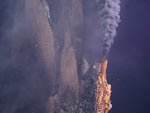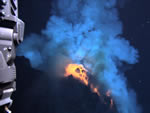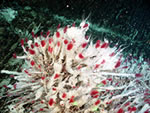Research Groups
Hydrothermal Venting:
Hydrothermal venting occurs when seawater circulates deep into the ocean crust, becomes heated, reacts with the surrounding rock, and jets back into the ocean at seafloor hot springs. VENTS studies the chemistry of hydrothermal fluids, gases, and mineral particles, and the plumes they form above the seafloor.
Hydrothermal Venting research groups:
Submarine Volcanism:
Submarine volcanism takes place in diverse tectonic settings in the worlds oceans and provides the heat source for most hydrothermal vents. VENTS uses ships, submersibles, and monitoring instruments to understand the geologic setting of seafloor hot springs and to discover active submarine volcanic processes.
Ecosystems:
Hydrothermal vents in the deep ocean host unique ecosystems where chemical energy nurtures life instead of sunlight. VENTS works with international collaborators in the fields of biology, microbiology, pharmacology, and ecology to understand the relationships between hydrothermal output, volcanic activity, and chemosynthetic ecosystems in the deep sea.



